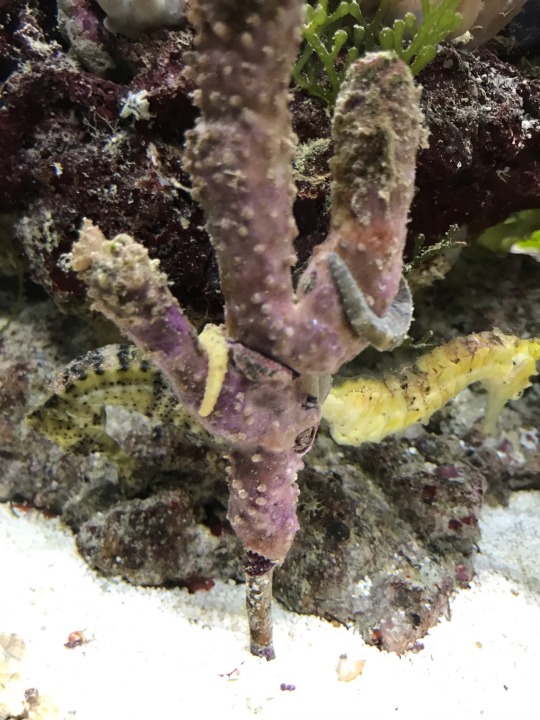#seahorse reidi
Text
MONSTROUS FUSION LINKS AS FISH AND OTHER AQUATIC CREATURES IF MONSTROUS FUSION WERE FISH OR OTHER AQUATIC CREATURES
All characters belong to @monstrous-fusion!!! This is my other mermay contribution. Each Link has a different place in the world of cultural inspiration, so at least one of the fish included for each is endemic to that region. Endemic means it is native to that specific area and not found (naturally) anywhere else in the world!! It’s really cool. There are some fish that are endemic to a singular lake!!!! Big lakes, but still one singular lake!!!! Or one reach of a tributary stream!!! It’s super cool.
Anyway. FISH!!!!! Image descriptions at the very bottom! :D

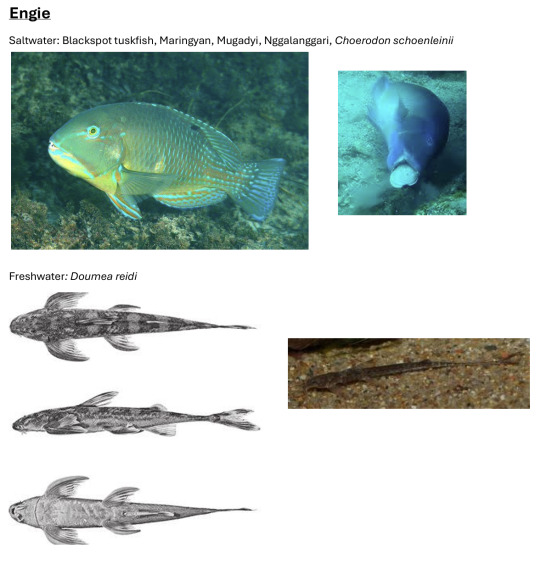


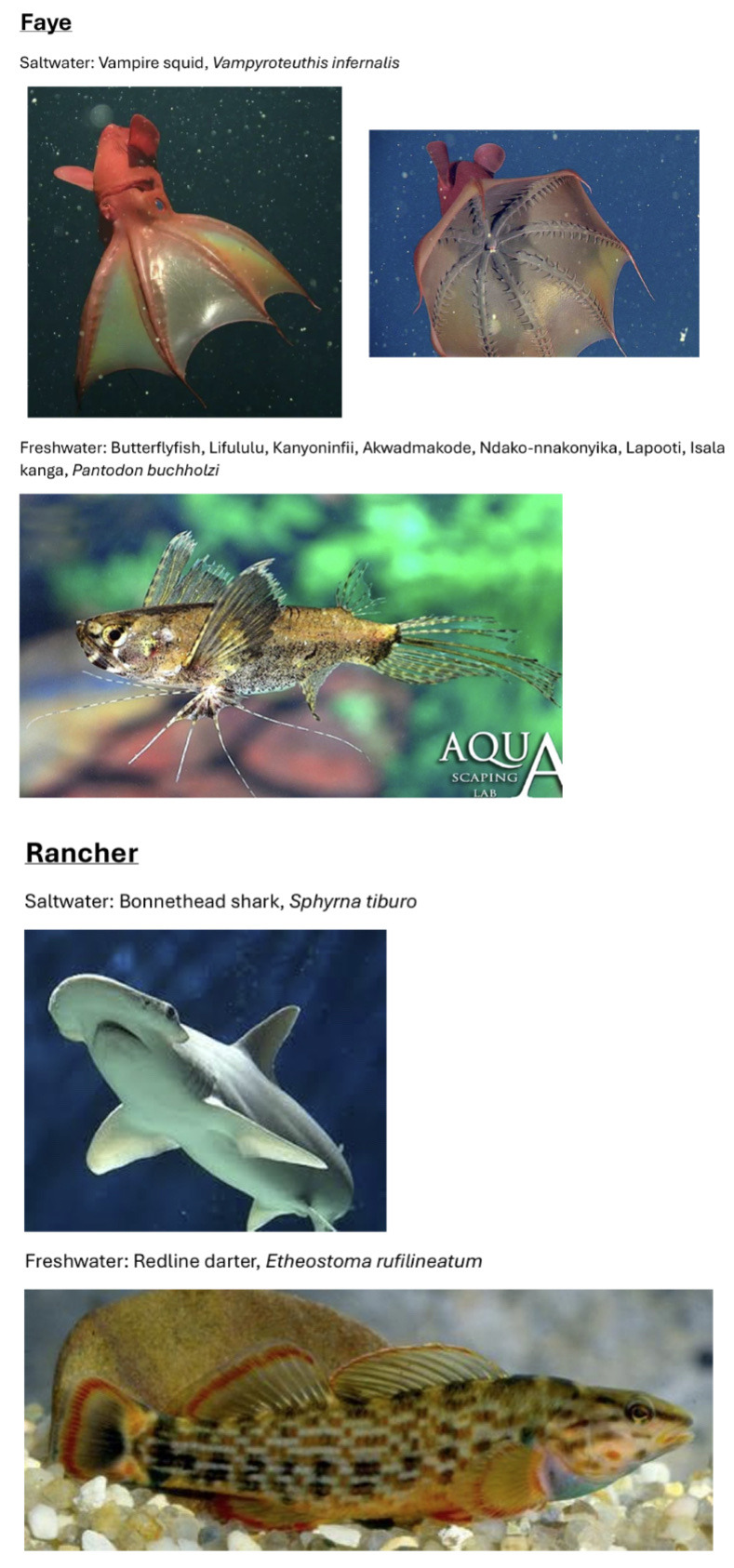
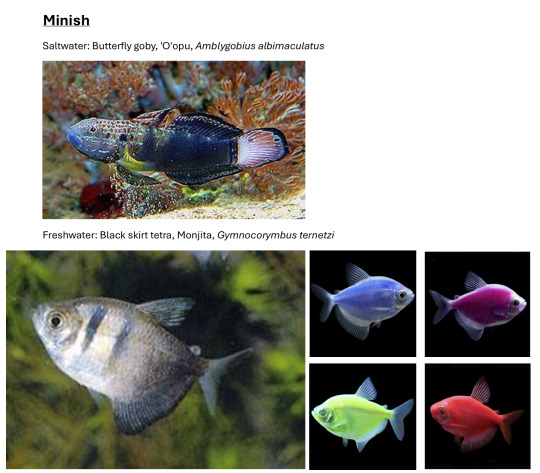
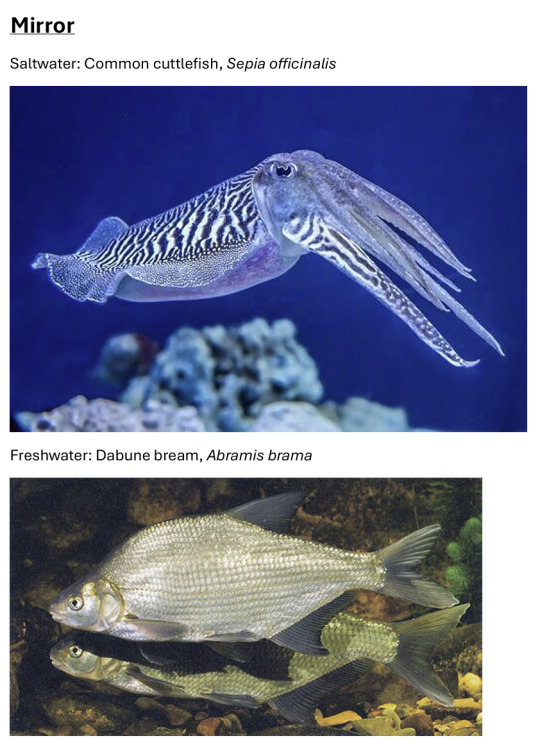
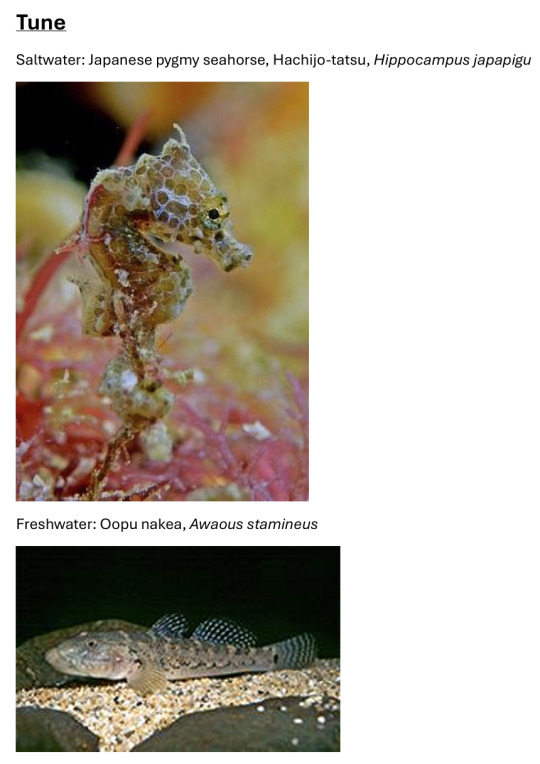

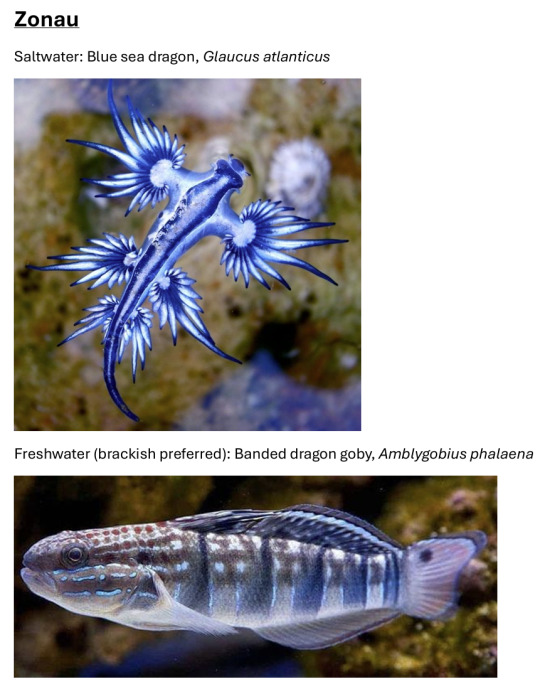
IMAGE ID: Images are the names of each link and then a saltwater fish and a freshwater fish. Each fish has the common name, the common name in the native language of wherever it is found, and then the scientific name. The fish are listed below. Since I am posting this on mobile I only have an English keyboard, so I am only including the common names in the ISO Latin alphabet in the descriptions.
Artisan. Saltwater: Transparent goby, Aphia minuta. Freshwater: Blue discus, Acará disco azul, Symphysodon aequifasciatus.
Engie. Saltwater: Blackspot tuskfish, Marigyan, Mugadyi, Nggalanggari, Choerodon schoeleinii. Freshwater: Doumea reidi.
Eras. Saltwater: Whale shark, Rhincodon typus. Freshwater: Evia barbel, Petropsaro, Barbus euboicus.
Faye. Saltwater: Vampire squid, Vampyroteuthis infernalis. FreshwaterL Butterflyfish, Lifululu, Kanyoninfii, Akwadmakode, Ndako-nnakonyika, Lapooti, Isala kanga, Pantodon buchholzi.
Rancher: Saltwater: Bonnethead shark, Sphyrna tiburo. Freshwater: Redline darter, Etheostoma ruffilineatum.
Minish: Saltwater: Butterfly goby, ‘O’opu, Amblygobius albimaculatus. Freshwater: Black skirt tetra, Monjita, Gymnocorymbus ternetzi.
Mirror. Saltwater: Common cuttlefish, Sepia officinalus. Freshwater: Dabune bream, Abranis brama.
Tune. Saltwater: Japanese pygmy seahorse, Hachijo-tatsu, Hippocampus japapigu. Freshwater: Oopu nakea, Awaous stamineus.
Feathers. Saltwater: Blotchwing flyingfish, Peshk fluturues, Rundinella, Uçan balik, Cheilopogon heterurus. Freshwater: Van loach, Oxynoemacheilus ercisianus.
Rue. Saltwater: Pearl-spotted wrasse, Sugale-uluvela, Drividrivi, Halichoeres margaritaceus. Freshwater: Chanchita, Australoheros tembe.
Wild. Saltwater: Ornate cowfish, Arcana ornata. Freshwater: Blunt-nosed Irish charr, Salvelinus obtusus.
Zonau. Saltwater: Blue sea dragon, Glaucus atlanticus. Freshwater (brackish preferred): Banded dragon goby, Amblygobius phalaena.
/END ID.
13 notes
·
View notes
Text
Animal Crossing Fish - Explained #204
Brought to you by a marine biologist and a fish with a straw, basically...
CLICK HERE FOR THE AS FISH EXPLAINED MASTERPOST!
I’ll be covering another one of the seahorses that were introduced earlier this year in AC Pocket Camp, and that means another opportunity to discuss these really strange fish. I mean, just look at them - upright with a long snout, a prehensile tail, poor swimming ability, a rigid body supported by hard, bony rings, and the male gives birth...I really understand why my grandmother never knew they were actually real animals. The fact that they are and live successfully this way is pretty incredible. So, we’ll talk about how they do that with a seahorse named after its feeding apparatus - the Longsnout Seahorse.

The Longsnout seahorse appeared in Fishing Tourney 49 in April 2022 with two other seahorses - the Pot-bellied and Lemur-tail seahorses. Honestly, I wish they’d gone a little further with this sprite - the Longsnout has lots of little spots, and seeing the amount of detail they have accomplished with other fish, it just looks like a yellow seahorse that I would have had a hard time narrowing down to species if it wasn’t already named.
Anyway, complaining aside, the Longsnout Seahorse (LS) is also called the Slender Seahorse, (Hippocampus reidi). It is native to the subtropical Atlantic around Latin America. Like other fish in Genus Hippocampus, they are poor swimmers that depend on sea bottom structure to literally “hold onto” with their tails.
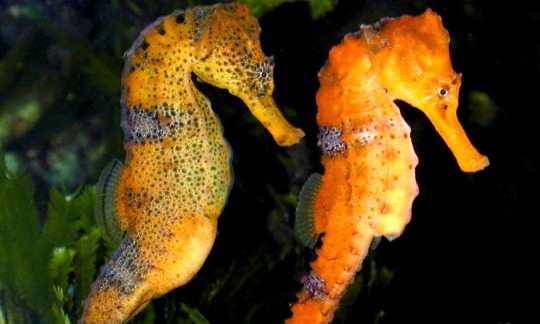
By Andreas März - https://www.flickr.com/photos/andreas63/4460491674/in/photolist [], CC BY 2.0, https://commons.wikimedia.org/w/index.php?curid=47109765
Seahorses live on a planktonic diet as ambush predators. I know, that sounds kinda weird to think of a seahorse as an ambush predator like a crocodile is an ambush predator, but they are. They will attach themselves to something and wait for prey to float by their faces. They then suction the prey into their tiny mouths. Lots of fish feed via suction like this - when they open their mouths, they create a vacuum in which water (and the prey in that water) is sucked into the void. Seahorses do this super fast!
youtube
Seahorsees also don’t have stomachs, so food passes through them really quickly. They need to eat a lot to survive and may feed 30 to 50 times a day just to keep up.
And there you have it. Fascinating stuff, no?
#slender seahorse#seahorse#fish#marine biology#animals#animal crossing#animal crossing pocket camp#acpc#science in video games#animal crossing fish explained
8 notes
·
View notes
Text

~ Noot Noot ~
#fishblog#fish#fishblr#fishtank#aquarium#beautiful fish#fishy love#fishy#seahorse pregnant#seahorse tank#seahorse feeding#seahorse aquarium#seahorse#seahorse marine#tiger tail seahorse#seahorse reidi#hippocampus reidi#reidi#sp reidi#pingu challenge#pingu#face
50 notes
·
View notes
Text
Imperial use of science/academia to construct what appears “natural’. Militarization of environmental sciences. Examples from biogeography research in nineteenth-century British empire in the North Atlantic.
---
Over the last few years, Atlantic Canada has been treated to ‘unusual marine visitors’ from the tropics, ranging from Gray Triggerfish, Tropical Sunfish, to rare Seahorses (Anon., 2012, Anon., 2014). Attributed to increases in warmer water temperatures, Neotropical species have become regular visitors to the shores of Nova Scotia and New Brunswick, delighting, surprising, and concerning people over climate change and impacts to native flora and fauna. While these allegedly tropical visitors are generally perceived to be out of place in the Nearctic region, research scientists are showing that, in fact, the presence of some tropical fish in Canada’s east coast is not a new phenomenon. Some species are present because of their northern distribution ranges, while others hitch ‘a ride on the Gulf Stream’ (Anon., 2012), illustrating the ways in which migrating species and larger marine systems transcend national, international, and zoogeographic boundaries. [...] Mobile fauna have become significant geopolitical actors in the politics of climate change, natural resources, and national security, as well as active agents in unsettling zoogeographic regions, distributions, and human values [...]
---
[N]ineteenth-century Britain established a defence network of squadrons, fortifications, and bases to secure economic and colonial control in the Atlantic, and to prevent the United States from invading Canada, since ‘Bermuda, conjointly with Halifax, [held] in check the whole Atlantic coast of the United States’ (Godet, 1860, p. 3). Known as the North America and West Indies Station (NAWI), the British military secured strategic ports and waterways, while the Royal Navy commanded the sea. Halifax, Nova Scotia, served as the summer headquarters while Bermuda held the winter station. From this network emerged the collection, documentation, and surveillance of natural phenomena – birds, fish, whales, ocean currents, weather systems – by British navy and military officers who were patrolling and garrisoning Atlantic Canada, Bermuda, and the West Indies. [...]
Moreover, Britain’s Admiralty, War Office, and Ordnance Department took active roles in establishing Humboldtian science as part of British naval and military culture (Reidy, 2008), which helped colonial officials contemplate the ‘habitability’ (Zeller, 2006) of imperial stations across the British Empire during a time when anxieties over climate, racial health, and military efficiency were prevalent; it also naturalized ‘northern forms… that successfully “invaded” southerly lands and moved in as “denizens”’ [...].
Considering that the NAWI Station was divided into two separate divisions in the British North Atlantic – Bermuda-Halifax and West Indies Divisions – how did colonial officials think about the differences between these two regions? Did these boundaries overlap with gendered and racial ideologies, and climatic and zoogeographical thinking of the time period (e.g. Old and New Worlds, Nearctic and Neotropical regions)? And how did migratory fauna, and other mobile ‘natures,’ animate and challenge these regional categories? [...]
---
[T]he production of biogeography by these individuals helped to map a climatic and zoogeographical boundary line between the temperate North Atlantic (Nearctic region) and the tropical West Indies (Neotropical region). These imperial environmental imaginaries, albeit contested, positioned Bermuda as part of the North America (Nearctic region) rather than the Caribbean (Neotropical region) as it had been in the pre-emancipation era. Furthermore, such imaginaries helped to naturalize a mobile imperial force that moved between Bermuda and Halifax in order to protect trading routes and to safeguard the region from the United States. Zoogeographic region-making [...], therefore, encompassed the discursive and material practices involved in attempting to make visible a unified militarized and zoogeographical region through Humboldtian science. [...]
In the Atlantic world, biogeography helped European naturalists observe differences between the ‘Old’ and ‘New World’ faunas for colonization and resource extraction [...]. The French naturalist, Comte de Buffon (1707–1788), was one of the first to define geographic regions as possessing different forms of life based on climatic conditions. [...] Buffon determined that ‘New World’ animals had degenerated from their ‘Old World’ form, exhibiting smaller physiques and slothful dispositions, which extended to Indigenous peoples of North America. [...]
As Julie Cruikshank (2005) has stated, ‘natural’ boundaries or borders can furnish clues for thinking about social order. In other words, they can illuminate how an ‘imagined “Nature” can become swept into the formation of nations’ [...].
---
Text above by: Kirsten Greer. “Zoogeography and imperial defence: Tracing the contours of the Neactic region in the temperate North Atlantic, 1838-1880s.” Geoforum Volume 65. October 2015. [Italicized first line/heading in this post added by me. Bold emphasis and some paragraph breaks/contractions added by me.]
35 notes
·
View notes
Photo

March 19, 2022 - This is a (LONGSNOUT SEAHORSE (Hippocampus reidi) here on Roatan taken this year (2022). Don't for get to visit my business account (Facebook - robertherbphotography & Instagram - robherbphoto) to see 5 photographs everyday. Visit my website (http://robertherb.com) to see all my photography. (at Subway Watersports Roatan) https://www.instagram.com/p/CbV_5uLLTRK/?utm_medium=tumblr
0 notes
Photo

Longsnout Seahorse – Hippocampus reidi
#seahorse#hippocampus#vector#gradient#graphic design#inthesea#Illustration#natureillustration#zsofia szabo#deep sea
12 notes
·
View notes
Text
Daily Dive Log May 20 - 26, 2018
Daily Dive Log May 20 – 26, 2018
View On WordPress
#Brown Garden eel#Caribbean sea horse#Cozumel#Cozumel animals#Cozumel critters#Cozumel fish#Cozumel Scuba#Cozumel Scuba Diving#Daily Dive Log#Green moray#Gymnothorax funebris#Heteroconger longissimus#Hippocampus reidi#Rainbow Parrotfish#Scarus guacamaia#SCUBA#Scuba Diving#Seahorse
0 notes
Photo
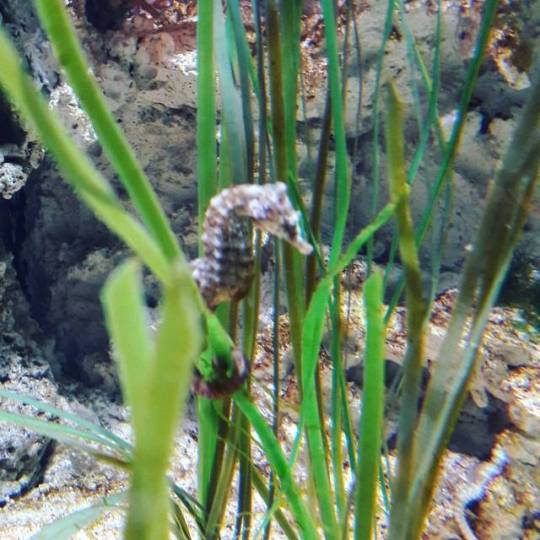
#kuonomerihevonen #slender #seahorse #hippocampus #reidi #sealife (paikassa Sea Life Helsinki)
0 notes
Photo

Surprises of the sea Long-snout Seahorse (Hippocampus reidi) registered in one of the snorkel dive, in the company of the friend Paulo Rodrigues, great defender of the seas! Despite having beautiful beaches, Vitória-ES, the city in which I was born, don't know your own underwater treasures! We already have people who cares, trying to change it arround here. Who wants to help? Who of my friends already dived here? --- PORTUGUÊS --- Surpresas do mar Cavalo-marinho registrado em um dos mergulhos com snorkel, na companhia do amigo Paulo Rodrigues, grande defensor dos mares! Apesar de ter lindas praias, Vitória-ES, a cidade em que nasci, não conhece sua própria riqueza submersa! Ja tem gente que se importa tentando mudar isso. Quem quer ajudar? Quem dos meus amigos já mergulhou por aqui? #underwater #fish #reef #coral #ocean #sea #water #diving #marine #aquatic #tropical #saltwater #ecosystem #snorkeling #swimming #seascape #submarine #nature #Seahorse #Hippocampusreidi #Hippocampus #Cavalomarinho #vitória #espíritosanto #brasil #brazil
#hippocampus#diving#aquatic#saltwater#nature#seahorse#fish#brasil#vitória#ecosystem#espíritosanto#sea#swimming#hippocampusreidi#seascape#snorkeling#marine#brazil#cavalomarinho#reef#ocean#coral#submarine#underwater#tropical#water
1 note
·
View note
Video
Não é todo dia que conseguimos gravar algo assim! Cavalo-Marinho de Focinho Longo (hippocampus reidi) alimentando-se de um camarão (palaemon elegans) e ainda sendo assistido de pertinho por um ‘Sargentinho’ (abudefduf saxatilis). Sim, eu amo muito tudo isso ❤️ Is not every day that we can catch this scene in video. Long-snout Seahorse eating a rockpool shrimp being inspected by a Sergeant fish! #aquario #aquariomarinho #fishtank #marinefishtank #aquarium #seahorse #longsnoutseahorse #rockpoolshrimp #sergeantfish #hippocampusreidi #palaemonelegans #abudefdufsaxatilis #smithsonian #smithsonianmarinestation #reef #reeftank #icapui #ceara (em Icapuí)
#marinefishtank#ceara#longsnoutseahorse#sergeantfish#hippocampusreidi#aquarium#aquario#reef#palaemonelegans#smithsonian#reeftank#fishtank#smithsonianmarinestation#icapui#seahorse#rockpoolshrimp#aquariomarinho#abudefdufsaxatilis
0 notes
Text
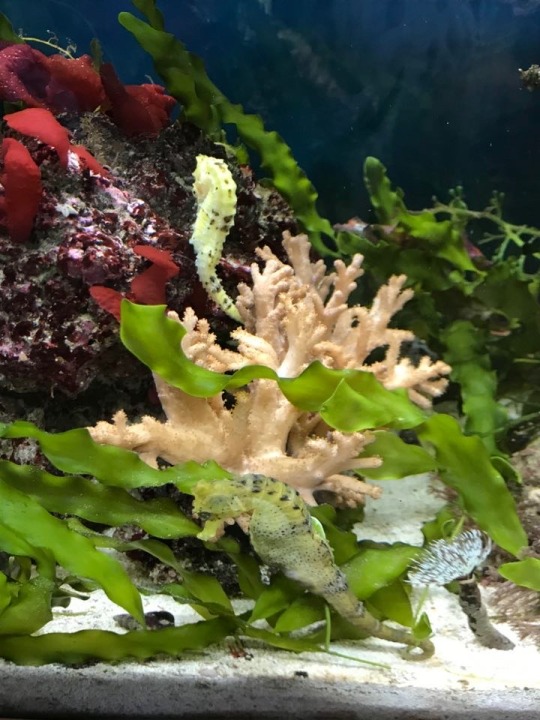
If fish can practise self-isolation... Then so can you 🤷🏻♀️
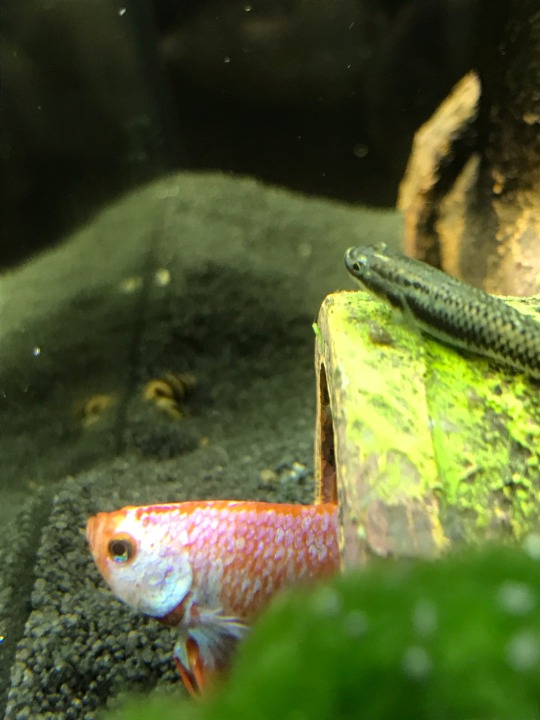
#fishblog#fish#fishyfriday#betta splendens#betta#seahorse reidi#seahorseblr#seahorse tank#seahorse pregnant#seahorse feeding#seahorse aquarium#seahorse marine#seahorse#tiger tail seahorse#marine#marine biology#bettatank#bettafancy#bettalove#betta advice#betta help#male betta#betta care#betta fish#bettablr#bettalovers#bettacommunity
28 notes
·
View notes
Text
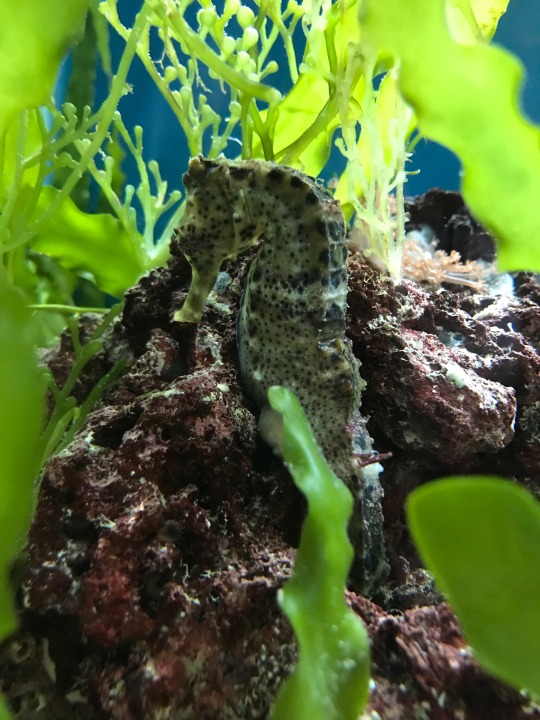
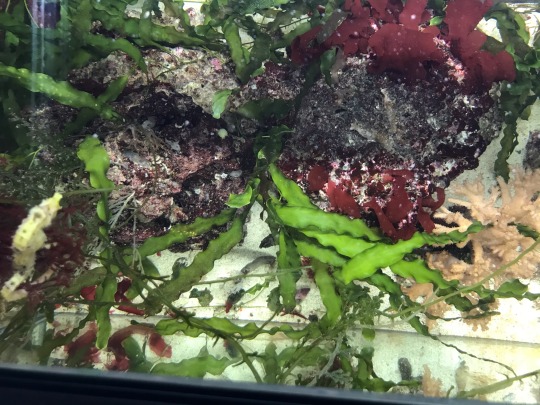
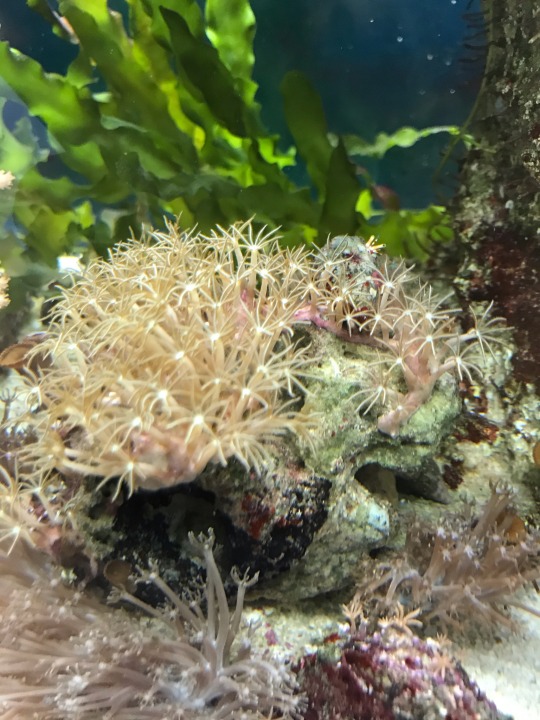

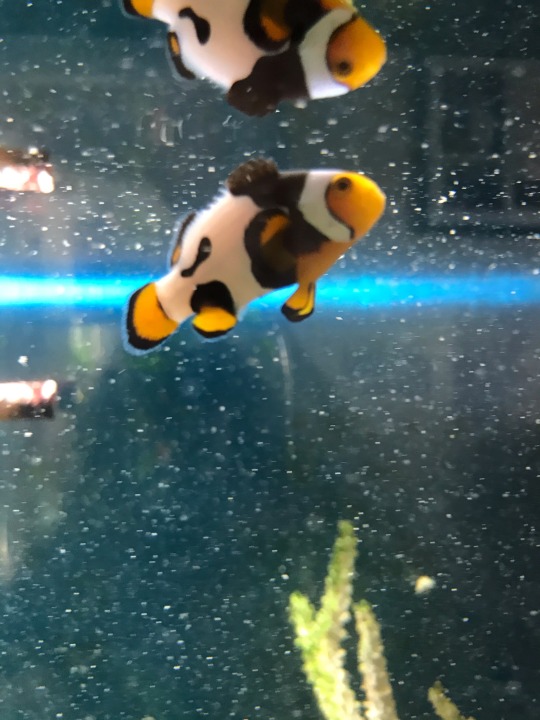
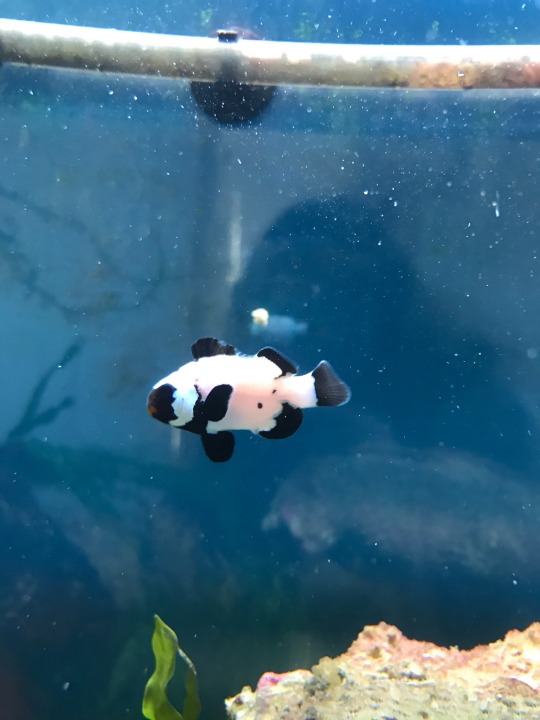

Update on fish -
Seahorses are doing really well. I have now grown live mysis in the tank and have an everlasting supply of them for the seahorses (I’ll still feed frozen as well)
Clowns are clowning as usual. They are getting so big now!
Kaida - Baby
Goby - Bestest little fish ever
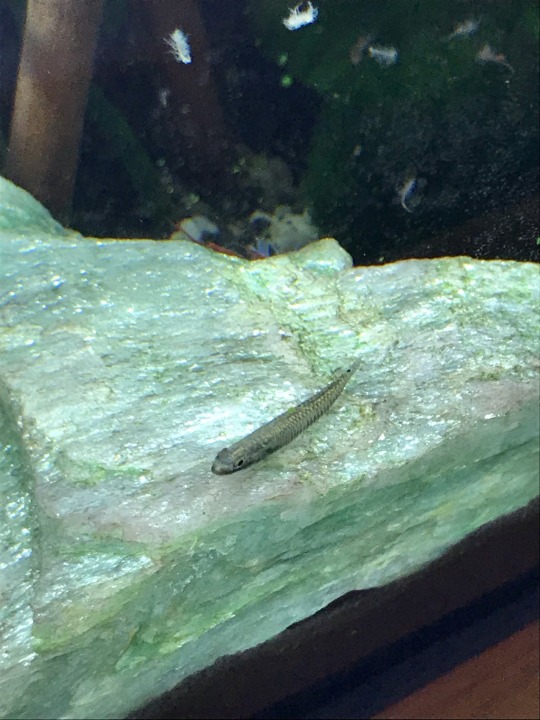
#fishy love#betta fish#fish#bettalove#seahorse#beautiful fish#bettatank#bettafancy#betta advice#betta care#bettablr#fishyfriday#fishblog#fish help#seahorse reidi#seahorseblr#seahorse feeding#seahorse tank#seahorse marine#marine#freshwater#male betta#goby#blueneonrivergoby#blue#neon#river#hermitblr#hermit#hermit crab
34 notes
·
View notes
Text

Always watching
#seahorse#fishblr#fishblog#fish help#bettablr#seahorseblr#seahorse reidi#seahorse pregnant#seahorse tank#seahorse marine#seahorse feeding#seahorse aquarium#tiger tail seahorse#beautiful fish#fishy#fish#fishyfriday#fishtank#aquarium#tank#naturaltank#naturalaquarium#plantedtank#plantedfishtank#plantedaquarium
20 notes
·
View notes
Text
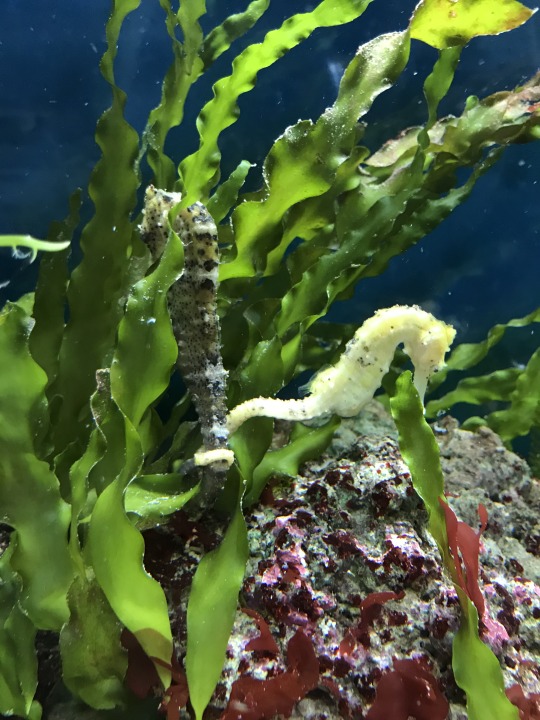
Hunting together ❤️
#aquarium#beautiful fish#fish#fishblog#fishblr#fishtank#fishy#fishy love#fishyfriday#betta#seahorse pregnant#seahorse tank#seahorse feeding#seahorse aquarium#seahorse#seahorse marine#hippocampus reidi#reidi#seahorse reidi#hippocampus
36 notes
·
View notes
Text

Dinner time in station!
#seahorse reidi#seahorse pregnant#seahorse tank#seahorse feeding#seahorse aquarium#seahorse#seahorse marine#tiger tail seahorse#aquarium#tank#fishblog#fish help#beautiful fish#fish#fishtank#fishblr#fishy#fishy love#seahorseblr#hermit crab#saltwater#marine#marine tank#saltwater tank#horsey#beautiful#couple#pregnant
13 notes
·
View notes
